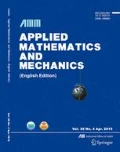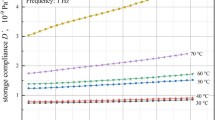Abstract
In order to predict the mechanical performance of the polyvinyl chloride (PVC) at a high operating temperature, a series of short-term tensile creep tests (onetenth of the physical aging time) of the PVC are carried out at 63 °C with a small constant stress by a dynamic mechanical analyzer (DMA). The Struik-Kohlrausch (SK) formula and Struik shifting methods are used to describe these creep data for various physical aging time. A new phenomenological model based on the multiple relaxation mechanisms of an amorphous polymer is developed to quantitatively characterize the SK parameters (the initial creep compliance, the characteristic retardation time, and the shape factor) determined by the aging time. It is shown that the momentary creep compliance curve of the PVC at 63 °C can be very well fitted by the SK formula for each aging time. However, the SK parameters for the creep curves are not constant during the aging process at the elevated temperatures, and the evolution of these parameters and the creep rate versus aging time curves at the double logarithmic coordinates have shown a nonlinear phenomenon. Moreover, the creep master curves obtained by the superposition with the Struik shifting methods are unsatisfactory in such a case. Finally, the predicted results calculated from the present model incorporating with the SK formula are in excellent agreement with the creep experimental data for the PVC isothermally aged at the temperature relatively close to the glass transition temperature.
Similar content being viewed by others
References
Visser, H. A., Bor, T. C., Wolters, M., Warnet, L. L., and Govaert, L. E. Influence of physical aging on impact embrittlement of uPVC pipes. Plastics, Rubber and Composites, 40(5), 201–212 (2011)
Struik, L. C. E. Physical Aging in Amorphous Polymers and Other Materials, Elsevier, Amsterdam, 34–39 (1978)
Read, B. E., Dean, G. D., Tomlins, P. E., and Lesniarek-Hamid, J. L. Physical aging and creep in PVC. Polymer, 33(13), 2689–2698 (1992)
Tomlins, P. E., Read, B. E., and Dean, G. D. The effect of temperature on creep and physical aging of poly (vinyl chloride). Polymer, 35(20), 4376–4381 (1994)
Dean, G. D., Tomlins, P. E., and Read, B. E. A model for nonlinear creep and physical aging in poly (vinyl chloride). Polymer Engineering & Science, 35(16), 1282–1289 (1995)
Read, B. E., Dean, G. D., and Tomlins, P. E. Creep and physical aging of PVC: dependence on stress and temperature. Journal of Non-Crystalline Solids, 172–174, 562–568 (1994)
Lee, H. H. D. and McGarry, F. J. A creep apparatus to explore the quenching and aging phenomena of PVC films. Journal of Materials Science, 26, 1–5 (1991)
Ever, J. B. and Kevin, J. F. Equivalent time temperature model for physical aging and temperature effects on polymer creep and relaxation. Journal of Engineering Materials and Technology, 126(4), 413–419 (2004)
Tomlins, P. E. Comparison of different functions for modeling the creep and physical aging effects in plastics. Polymer, 37(17), 3907–3913 (1996)
Zerafati, S. and Janine, B. Effect of physical aging on the impact retention and heat distortion temperature of vinyl products. Journal of Vinyl and Additive Technology, 4(4), 240–245 (1998)
Elvira, B. R. and James, W. S. The effect of physical aging on properties of rigid polyvinyl chloride. Journal of Vinyl Technology, 14(3), 126–130 (1992)
Lee, H. H. D. and McGarry, F. J. Changes in free volume and mechanical properties of PVC films incurred by quenching and aging. Journal of Macromolecular Science: Physics, B29(1), 11–29 (1990)
Odegard, G. M. and Bandyopadhyay, A. Physical aging of epoxy polymers and their composites. Journal of Polymer Science, Part B: Polymer Physics, 49(24), 1695–1716 (2011)
Bradshaw, R. D. and Brinson, L. C. Physical aging in polymers and polymer composites: an analysis and method for time-aging time superposition. Polymer Engineering & Science, 37(1), 31–44 (1997)
Kovacs, A. J., Aklonis, J. J., Hutchinson, J. M., and Ramos, A. R. Isobaric volume and enthalpy recovery of glasses, II. a transparent multiparameter theory. Journal of Polymer Science: Polymer Physics Edition, 17(7), 1097–1162 (1979)
Author information
Authors and Affiliations
Corresponding author
Additional information
Project supported by the National Natural Science Foundation of China (Nos. 10672095 and 11072137) and the Shanghai Leading Academic Discipline Project (No. S30106)
Rights and permissions
About this article
Cite this article
Zhou, Zh., He, Yl., Hu, Hj. et al. Creep performance of PVC aged at temperature relatively close to glass transition temperature. Appl. Math. Mech.-Engl. Ed. 33, 1129–1136 (2012). https://doi.org/10.1007/s10483-012-1610-x
Received:
Revised:
Published:
Issue Date:
DOI: https://doi.org/10.1007/s10483-012-1610-x




